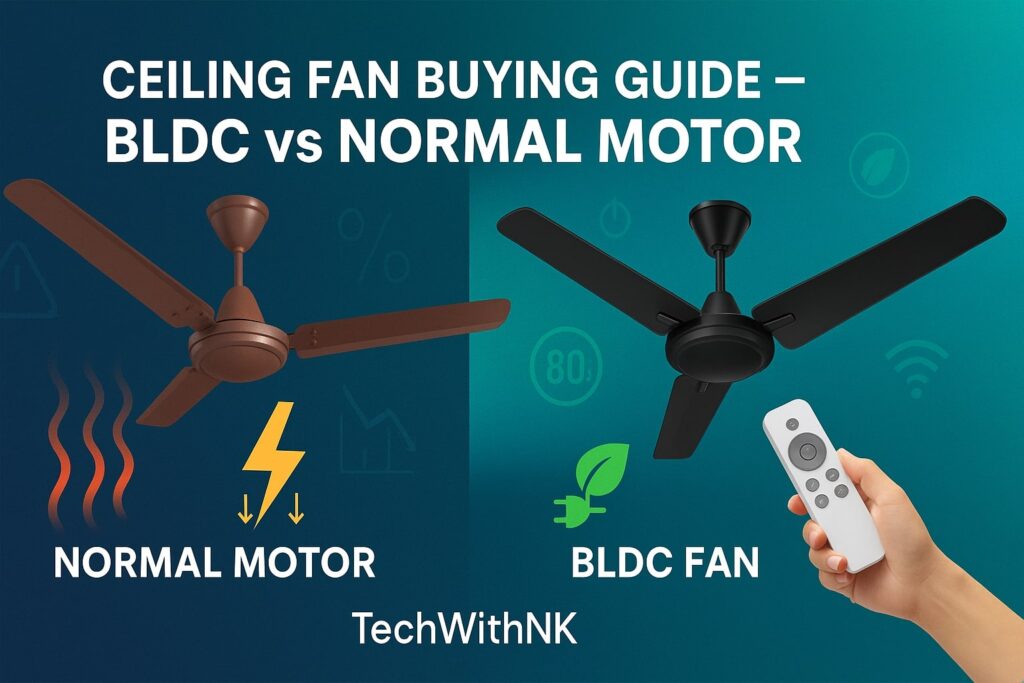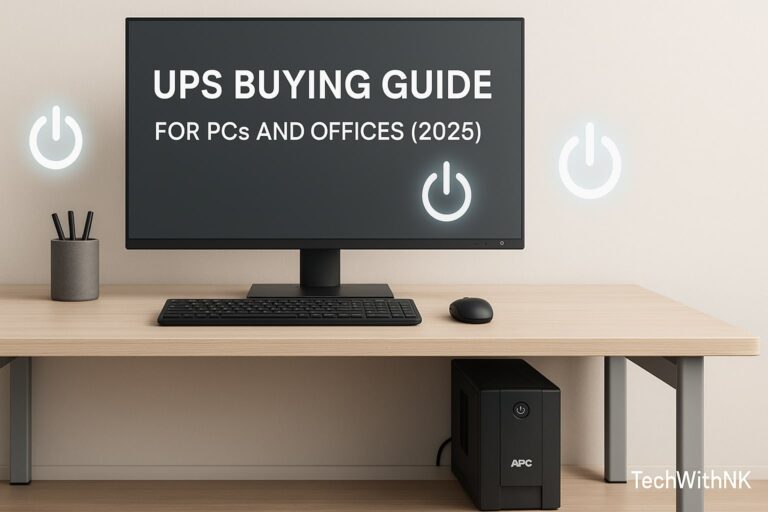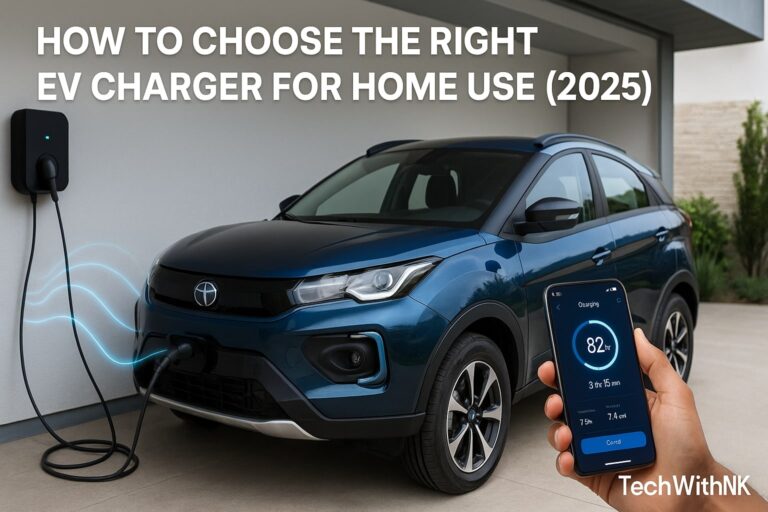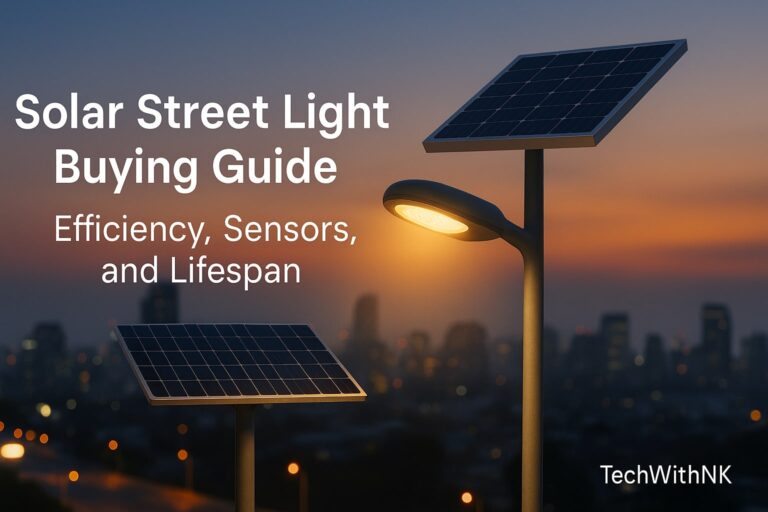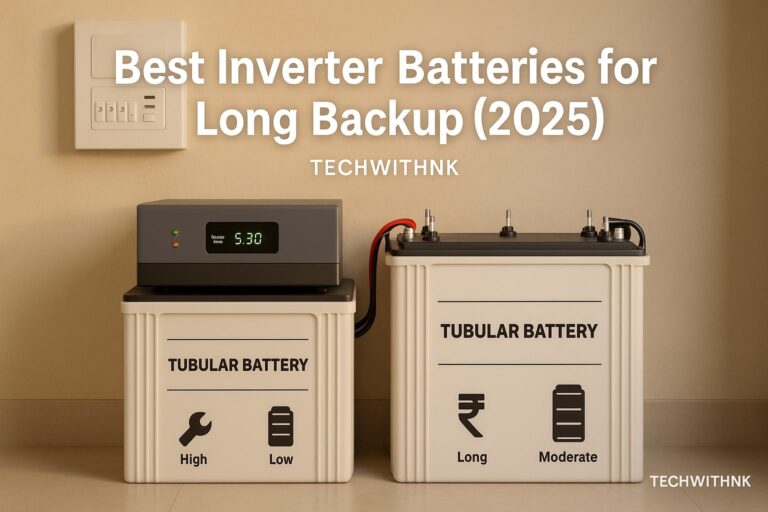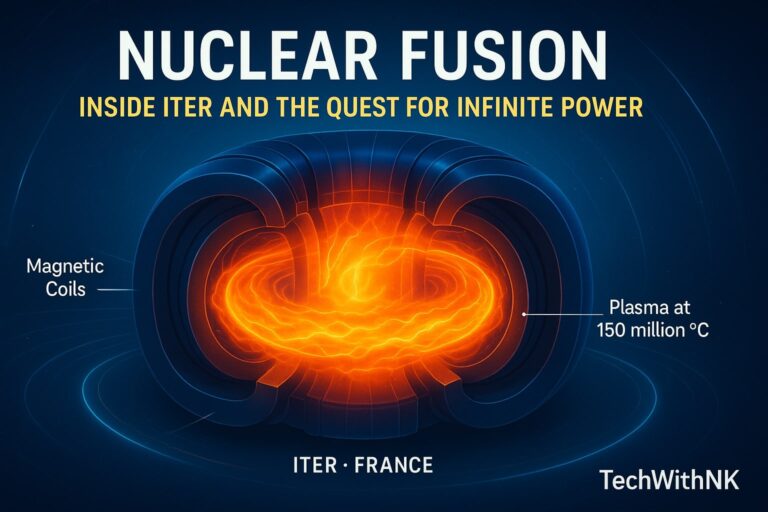🏡 Introduction: Why Ceiling Fans Still Matter in Every Indian Home
Even in the age of air conditioners and smart cooling devices, the ceiling fan remains the most essential appliance in Indian homes. From rural houses to modern apartments, fans are used almost 12–16 hours a day — especially in tropical climates like India.
But with the rising cost of electricity and the push for energy efficiency, the market is shifting from normal induction motor fans to BLDC (Brushless Direct Current) fans.
So what’s the difference?
Are BLDC fans really worth the extra cost?
How much electricity can they actually save?
This TechWithNK Buying Guide will answer all your questions — with real examples, efficiency data, and a complete buying checklist.
Understanding the Basics: What Is a Ceiling Fan and How It Works?
A ceiling fan converts electrical energy into mechanical motion to circulate air and create a cooling effect through air movement, not by lowering temperature.
Components of a Typical Ceiling Fan
Motor (heart of the fan) – converts electrical power to rotation.
Blades – push the air downward.
Capacitor – helps start and regulate motor speed.
Regulator – adjusts speed.
Downrod and Canopy – support and hide wiring.
The motor type is the key factor that defines performance, power consumption, and lifespan.
There are two main types used today:
Conventional Induction Motor (Normal Fan)
BLDC Motor (Brushless DC Motor)
Normal Ceiling Fan (Induction Motor) – Working Principle
Traditional fans use an AC Induction Motor, which works on electromagnetic induction.
When AC current passes through the stator windings, it creates a rotating magnetic field that induces current in the rotor, producing torque.
🔩 Features:
Operates directly on 230V AC supply
Uses copper/aluminium windings
Speed control through a resistive regulator or electronic step regulator
Common wattage: 70–90W
Average lifespan: 5–8 years
✅ Advantages:
Low initial cost (₹1,200–₹2,000)
Easy availability and repairable
Time-tested technology
❌ Disadvantages:
High power consumption
Generates more heat
Speed drops during voltage fluctuation
Wastes energy at low speeds (resistor regulator loss)
No smart features
BLDC Ceiling Fan – Working Principle Explained
BLDC stands for Brushless Direct Current Motor.
It uses DC power (converted internally from AC through an SMPS circuit) and electronic commutation instead of mechanical brushes.
The rotor contains permanent magnets, while the stator carries electronic coils. The microcontroller inside the fan’s circuit controls current timing — leading to smooth, efficient, and silent operation.
⚙️ BLDC Fan Technology Highlights:
| Parameter | BLDC Fan | Normal Fan |
|---|---|---|
| Motor Type | Brushless DC | Induction |
| Power Input | AC (converted to DC) | AC Direct |
| Commutation | Electronic | Electromagnetic |
| Controller | Microcontroller/Driver IC | None |
| Efficiency | 70–80% | 30–50% |
| Speed Stability | Constant | Drops on low voltage |
| Power Consumption | 25–35W | 70–90W |
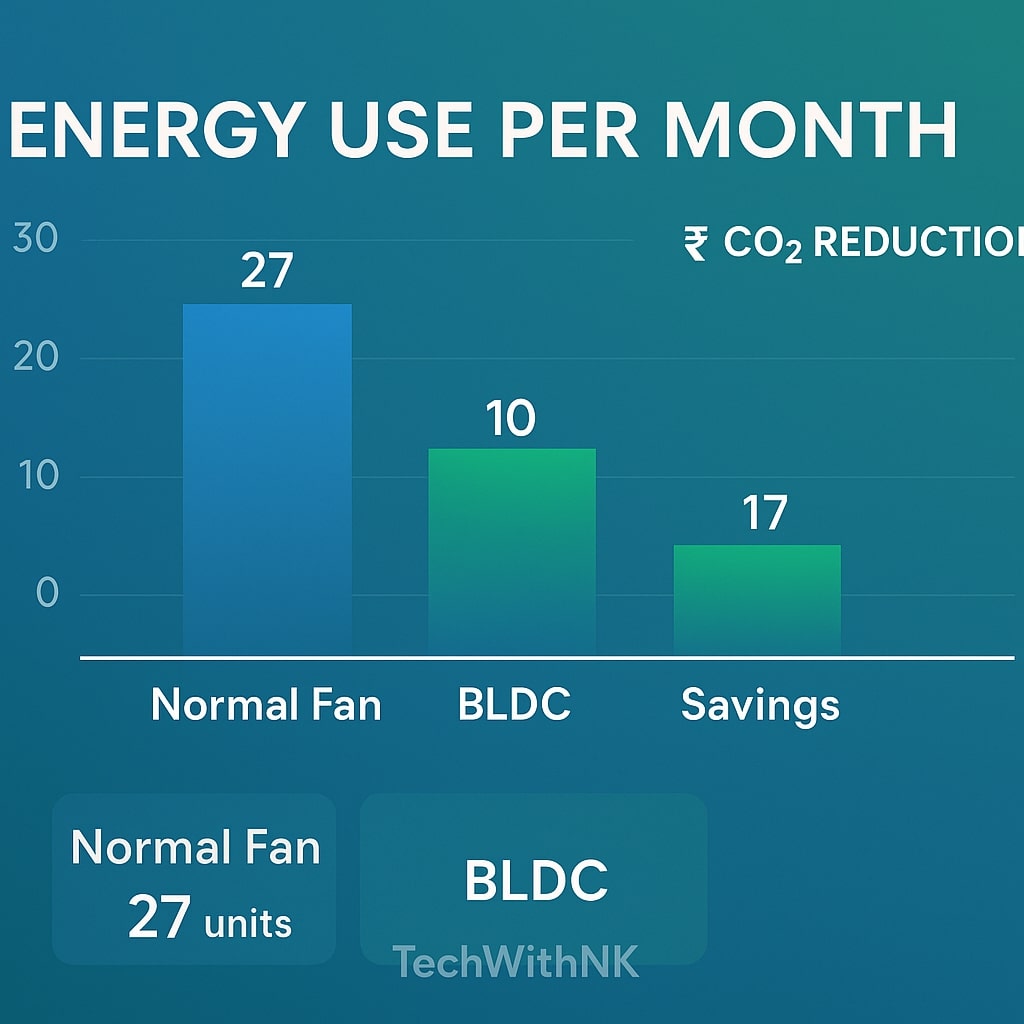
Power Consumption Comparison: BLDC vs Normal Fan
Let’s take a real-world example.
| Parameter | BLDC Fan | Normal Fan |
|---|---|---|
| Power Rating | 28W | 75W |
| Operating Hours per day | 12 | 12 |
| Units per month (30 days) | (28×12×30)/1000 = 10.08 kWh | (75×12×30)/1000 = 27 kWh |
| Electricity Cost @ ₹7/unit | ₹70.56 | ₹189 |
| Monthly Savings | ₹118.44 | — |
| Annual Savings | ₹1,421 | — |
➡️ Over a 5-year life, savings ≈ ₹7,000, which is far greater than the price difference between a BLDC and normal fan.
Technical Deep Dive: How BLDC Improves Efficiency
Electronic Commutation:
Eliminates mechanical friction from brushes, reducing energy loss.Permanent Magnet Rotor:
Reduces rotor copper loss (no induced current).Microcontroller-based Drive:
Ensures precise speed control, smooth acceleration, and constant RPM even during low voltage.DC Regulation:
DC motors inherently have better torque-speed control and lower energy loss.Power Factor Improvement:
Typical BLDC fan PF ≈ 0.95 vs normal fan PF ≈ 0.8.
Noise and Vibration Comparison
| Factor | BLDC Fan | Normal Fan |
|---|---|---|
| Noise Level | < 55 dB (Silent) | 65–75 dB (Audible hum) |
| Motor Heating | Very low | High |
| Vibration | Negligible | Slight due to rotor imbalance |
| Bearing Life | Longer (sealed) | Shorter |
BLDC fans are ideal for bedrooms and offices where silent operation matters.
Smart Features in Modern BLDC Fans
Most BLDC fans today come with IoT and smart control features that make them more advanced than traditional fans.
Common Features:
Remote Control Operation
Smart App or Wi-Fi Control
Voice Control (Alexa/Google Home)
Sleep and Timer Modes
Reverse Rotation Mode (for winters)
Memory Retain Function
Auto Sleep / Breeze Mode
These features make BLDC fans a part of the smart home ecosystem.
Price Comparison (2025 Indian Market)
| Type | Typical Price Range | Example Models |
|---|---|---|
| Normal Ceiling Fan | ₹1,200 – ₹2,000 | Usha Swift, Crompton Aura, Bajaj Bahar |
| Premium Normal Fan | ₹2,000 – ₹3,000 | Havells Pacer, Orient Wendy |
| BLDC Ceiling Fan | ₹3,000 – ₹5,500 | Atomberg Renesa, Orient Aeroquiet BLDC, Crompton Energion |
| Smart BLDC Fan | ₹4,500 – ₹7,000 | Atomberg Renesa Smart+, Havells Efficiencia Neo Smart |
💡 Tip: The upfront cost is higher, but BLDC pays back in 1.5–2 years through energy savings.
Voltage Fluctuation & Speed Stability
Normal fans run slower when voltage drops below 200V.
BLDC fans, however, have an internal SMPS (Switch Mode Power Supply) that maintains constant speed even if voltage fluctuates between 90V–300V.
Hence, ideal for areas with frequent voltage variations or inverter use.
Inverter Compatibility and Backup Duration
During power cuts, most Indian households rely on inverters.
Since BLDC fans consume less than half the power, they can run 2–3× longer on the same battery.
Example:
A 12V, 150Ah battery = 1800 Wh
Normal fan (75W): runs ~24 hours total
BLDC fan (28W): runs ~64 hours total
Hence, BLDC = ideal for inverter setups.
Heat Generation and Longevity
BLDC motors generate very little heat because of efficient electronic switching.
Induction motors heat up significantly, especially after long operation.
Less heat means:
Longer winding life
Lower bearing wear
Stable performance
Cooler room environment
Expected lifespan:
Normal Fan: 5–8 years
BLDC Fan: 10–15 years
Maintenance and Repair
| Aspect | BLDC Fan | Normal Fan |
|---|---|---|
| Maintenance | Almost zero | Regular (bearing, capacitor) |
| Common Failure | Driver PCB (rare) | Capacitor, winding, bearing |
| Repair Availability | Limited (brand service only) | Easily available locally |
| Spare Cost | Medium to High | Low |
💬 Verdict: BLDC fans need less maintenance but require brand service support for PCB issues.
Buying Checklist: What to Check Before You Buy
| Checklist Item | Recommended for BLDC Fan |
|---|---|
| Blade Sweep Size | 1200 mm (for standard rooms) |
| Power Rating | 25–35W |
| Air Delivery | >220 CMM |
| Speed (RPM) | 340–380 |
| Remote Control | Preferable |
| Warranty | 2–3 years minimum |
| Brand Reputation | Atomberg, Crompton, Havells, Orient, Superfan |
| Noise Level | < 60 dB |
| Smart Features | Optional but useful |
Top BLDC Ceiling Fans in India (2025)
| Brand | Model | Power | Air Delivery | Features | Price |
|---|---|---|---|---|---|
| Atomberg | Renesa+ | 28W | 235 CMM | Remote, Smart App | ₹3,500 |
| Crompton | Energion HS | 35W | 220 CMM | Remote | ₹3,200 |
| Havells | Efficiencia Neo | 26W | 220 CMM | BEE 5-Star | ₹3,800 |
| Orient | I-Tome | 28W | 230 CMM | IoT + Voice | ₹4,500 |
| Superfan | Super X1 | 35W | 230 CMM | BLDC | ₹3,400 |
Electricity Bill Savings Calculator (Example)
If you have 4 ceiling fans running 12 hours/day:
| Type | Power per Fan | Total Monthly Units | Monthly Bill | Annual Bill |
|---|---|---|---|---|
| Normal Fan | 75W | 108 kWh | ₹756 | ₹9,072 |
| BLDC Fan | 28W | 40.3 kWh | ₹282 | ₹3,384 |
→ You save ₹5,688 per year
Over 10 years = ₹56,880 saved 💰
Environmental Benefits
Switching to BLDC fans not only saves money but also reduces carbon emissions.
For every 1 unit (kWh) of electricity saved, 0.8 kg of CO₂ emission is reduced.
Average home savings:
4 fans → Save 68 kWh/month
Annual CO₂ reduction: 652 kg
Equivalent to planting 30 trees every year 🌳.
When to Choose a Normal Fan Instead
You may still prefer a normal fan if:
You need a low-cost fan for a rental property.
Power fluctuations are rare and energy bill is minimal.
You live in an area with no access to brand service centers.
You prefer DIY repairs over brand servicing.
Future of Ceiling Fans – Smart, Efficient, and Connected
The future belongs to smart BLDC fans integrated with home automation.
Expect features like:
Motion sensors (auto ON/OFF)
Adaptive speed based on temperature
Integration with solar and smart meters
Predictive maintenance alerts
Soon, your fan will talk to your smart home system — adjusting airflow based on your comfort pattern.
Ut elit tellus, luctus nec ullamcorper mattis, pulvinar dapibus leo.
Summary Table – BLDC vs Normal Fan
| Feature | BLDC Ceiling Fan | Normal Ceiling Fan |
|---|---|---|
| Power Consumption | 25–35W | 70–90W |
| Efficiency | High (80%) | Moderate (40%) |
| Speed Control | Electronic | Resistive |
| Noise | Low | High |
| Heat | Minimal | High |
| Lifespan | 10–15 years | 5–8 years |
| Maintenance | Very Low | Medium |
| Smart Features | Yes | No |
| Voltage Stability | Excellent | Poor |
| Price | ₹3k–₹5k | ₹1.5k–₹2.5k |
| Running Cost | Low | High |
| Inverter Backup | 2–3× longer | Short |
| Overall Verdict | ✅ Best for energy saving | ⚙️ Basic option |
🧭 Final Verdict
If you value long-term savings, silent operation, and modern technology,
👉 Choose BLDC fans.
They may cost ₹1,500 more upfront, but they’ll pay for themselves in under two years — and keep saving money and energy for a decade.
For rental or temporary setups, a normal induction fan still works fine.
But for your own home, a BLDC ceiling fan is the smart, efficient, and future-ready choice.
